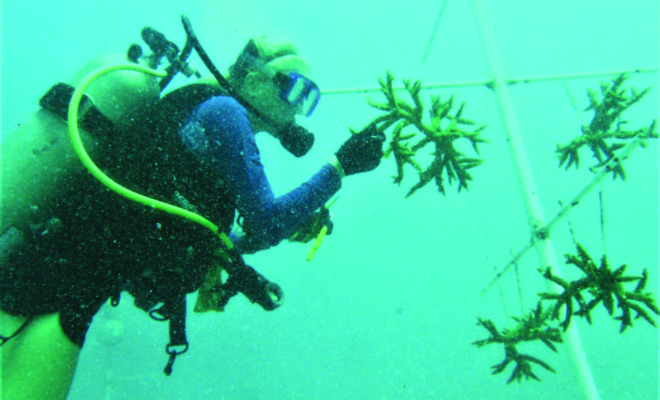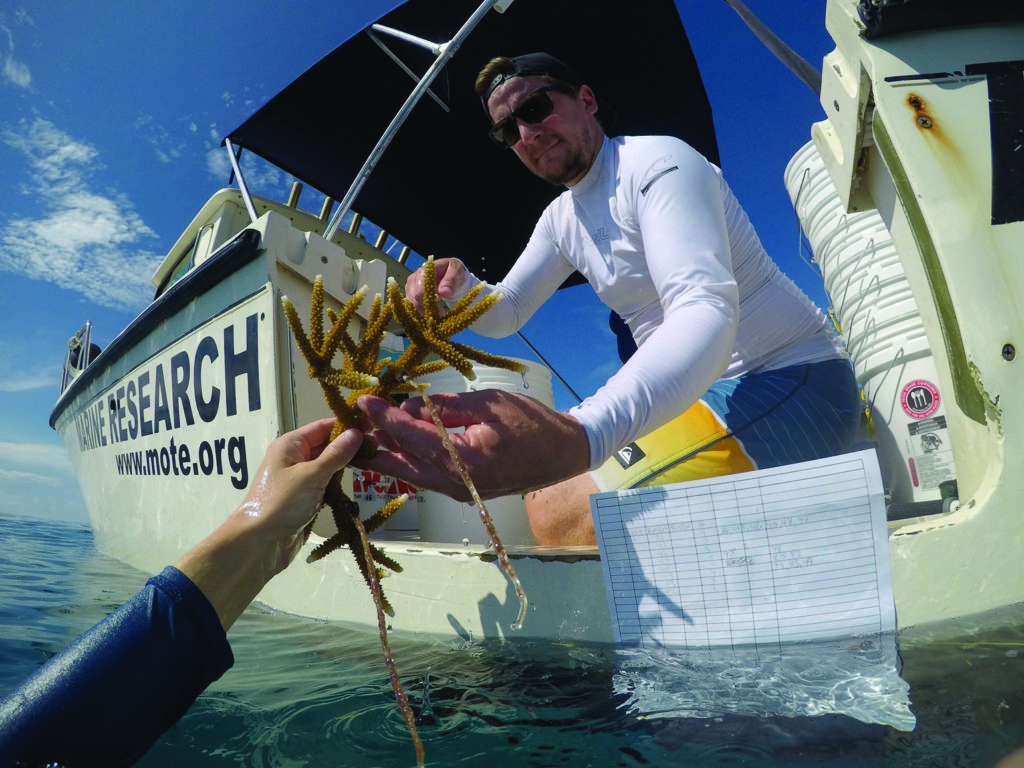
Feature
Mote’s Mission to Save Coral Reefs
By Ryan G. Van Cleave
While many know Mote as the place to find 100 species of marine animals such as manatees, sea turtles, and sea jellies—not to mention the 135,000-gallon shark habitat—it’s also a working laboratory where cutting-edge scientific research happens on a daily basis. One of the most urgent issues they’re seeking to address is the deterioration of Florida’s coral reefs, which are being ravaged by disease, ocean warming, and the increased acidification of the water.
Much of this work is being done at Mote’s IC2R3 (Elizabeth Moore International Center for Coral Reef Research & Restoration) campus in Summerland Key. The IC2R3’s Science Director, Dr. Erinn Muller, says that coral reefs are the most biologically diverse ecosystem in the ocean and help to support over 25% of all marine life. In essence, they’re the backbone of life in the oceans.
“In addition,” she adds, “coral reefs provide an immense amount of ecosystem services including shoreline protection and they offer novel sources for medicine, food, and jobs to over 1 billion people around the world.” Perhaps most important in terms of a local focus, she explains that coral reefs are an economic driver. The Florida Reef Tract alone provides 70,000+ jobs and is estimated to be worth $6 billion annually to Florida’s economy. Considering that since the 1970s, the Florida Reef Tract has lost more than 95% of its once-flourishing hard coral cover, this is a pressing issue. Without urgent change, all coral reefs may be gone by the end of the century.
That’s a future marine scientists like those at Mote are committed to changing, however.

Dr. Hanna R. Koch, a Postdoctoral Fellow with The German Research Foundation and Visiting Research Scientist at Mote, says that the IC2R3 has taken a big step forward this year in “completing the entire loop of resilience-based coral reef restoration involving both asexual and sexual propagation.” She further explains that “Asexual propagation, via coral gardening, produces large numbers of resilient corals that are used for increasing coral cover more quickly on degraded reefs. Sexually propagated coral offspring represent the next generation of genetically distinct individuals that may have certain traits, like increased temperature tolerance or disease resistance, that make them better adapted to stressful environmental conditions.”

In short, the corals being produced today are better able to withstand the increasingly challenging environmental conditions that have proven disastrous to previous generations of coral. That’s the only way to help revive critically endangered coral like staghorn and elkhorn.
Dr. Koch says that sexual reproduction is crucial for the survival and long-term persistence of coral reefs, and this year, she’s carried out the first complete round of sexual propagation, including spawning, fertilization, and settlement, using Mote’s own broodstock of staghorn corals. Thanks to the work being done at IC2R3, they now have 200 new coral babies that will be used to add fresh genetics to their Coral Reef Restoration Program in the Florida Keys. “Given that for some species and regions, sexual cycles are failing in the wild as a result of increased environmental degradation,” notes Dr. Koch, “this achievement marks an important first step in the development of a managed breeding program as part of Mote’s resilience-based coral reef restoration strategy.”
What many simply don’t understand is that coral reefs are deeply affected by the ongoing rapid change of the Earth’s climate. “Corals are indeed animals,” explains Dr. Koch, “but they have evolved a symbiotic relationship with microscopic plants that they host inside their tissues, called algae. These special algae convert the sun’s energy into food for the coral host through the process of photosynthesis and provide more than 90% of the coral’s nutritional requirements.”
As a result of global warming, the sea surface temperatures of the ocean can become too high, which means the coral host gets stressed out and expels these vital energy-producing symbionts in a process called “coral bleaching.” This act leaves the now-colorless animal appearing as bright white, which means it’s starving.
As a result of global stressors (like increased temperatures) and local stressors (like increased disease outbreaks and pollution), in the last forty years alone, we’ve lost more than 50% of the Earth’s coral reefs, and a devastating 80% of those in the Caribbean. Given that coral reefs are some of the longest living ecosystems on this planet, having been around for more than 250 million years, this rapid and widespread loss is an issue that more people should be aware of.
But thanks to the amazing staff at Mote that has dedicated much of their lives’ work to coral restoration, positive results are coming in. Dr. Muller says that “it’s heartening to see that the corals we care for every day routinely have a 90% survival rate after placing them back onto the reef. Because of the techniques that Mote staff has developed, and our care and dedication to reef conservation, coral restoration is a viable method that can bring our coral reefs back to life within our lifetime.”
For more information on Mote Marine Laboratory, please visit www.mote.org or call 941.388.4441.



You must be logged in to post a comment Login